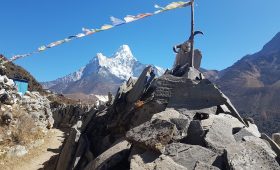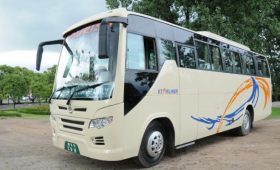Kangchenjunga is the third highest peak in the world. This trek is one of the best treks in Nepal that granting an incredible opportunity to experience completely different vegetation and fauna, remoteness, glorious mountain landscapes, as well as nice native culture.
The Kanchenjunga ‘Five Treasures of Snow’ (“kang” – “snow” or “ice” “chen” – “great” “jun” – “treasure” “inga” – “five”) which is in credit to the five summits which form up Kanchanjunga, is typically worshiped by the local people. While on the route you’ll be able to notice many tiny communities their customs and tradition. Limbu, Sherpa, Rai and Gurung are the most ethnic inhabitants in this zone. Hey, never miss the chance to test Tongba, a warm and soft local alcohol, that is offered in the brass ringed wood pot.
Keep in mind that the trails are narrow and the teahouses are basic, as this remote area is still visited by relatively few trekkers. On the famous trekking routes, you will not find the fancy meals and attached bathrooms available, but you will experience true Nepal in all its diversity of cultures and landscapes.
The trail leads northeastwards to Yalung Base Camp 4500m afterward turns western side throughout some of the passes, then keeps up to the Ghunsa wherever it climbs up to the Kanchenjunga Base Camp (5143 m) facing superb higher alpine surroundings, then gets back southwest to Taplejung, the beginning and final spot of the Kangchenjunga Circuit trek.
The Kanchenjunga trek starts from Suketar in Taplejung district, which is typically accessible by domestic plane, or as an alternative, is also approachable by a road from Basantapur. The long trek on a less populated route is somewhat plus point for us, with an artless perception of lifestyle in Nepalese rural areas and its eye-catching scenery.
Kanchenjunga Trek Itinerary
| Days | Itinerary | Altitude | Time | |
|---|---|---|---|---|
| Day 1 | Arrive in Kathmandu. | 1400m | ||
| Day 2 | Free in Kathmandu for sightseeing and pre trip briefing and gear check. | |||
| Day 3 | Fly to Taplejung and trek to Lali Kharka. | 2276m | 3 hrs. | |
| Day 4 | Trek to Khesewa. | 2120m | 5 - 6 hrs. | |
| Day 5 | Trek to Mamankhe. | 1920m | 5 hrs. | |
| Day 6 | Trek to Yamphudin. | 2080m | 6 hrs. | |
| Day 7 | Trek to Chitre. | 2965m | 5 hrs. | |
| Day 8 | Trek to Tortong. | 3010m | 6 hrs. | |
| Day 9 | Trek to Tseram. | 3870m | 6 hrs. | |
| Day 10 | Trek to Ramche. | 4580m | 4 - 5 hrs. | |
| Day 11 | Discover around Ramche and trek to Oktang. | 4730m | 5 hrs. | |
| Day 12 | Trek to Yalung Ri Base Camp. | 5400m | 5 hrs. | |
| Day 13 | Trek back to Ramche. | 4580m | 4 - 5 hrs. | |
| Day 14 | Trek to Sele La over the Mirgin La. | 4480m | 6 hrs. | |
| Day 15 | Trek to Ghunsa. | 3475m | 5 hrs. | |
| Day 16 | Trek to Kambachen. | 4040m | 6 hrs. | |
| Day 17 | Discover Kambachen. | |||
| Day 18 | Trek to Lhonak. | 4790m | 5 - 6 hrs. | |
| Day 19 | Trek to Pang Pema. | 5140m | 4 hrs. | |
| Day 20 | Discover around Kanchenjungha Base Camp (5280m) and retrace your steps to Kambachen. | 5280m | 5 hrs. | |
| Day 21 | Trek to Ghunsa. | 3475m | 6 hrs. | |
| Day 22 | Trek to Amjilosa. | 2460m | 4 hrs. | |
| Day 23 | Trek to Sakathum. | 1600m | 5 hrs. | |
| Day 24 | Trek to Chhiruwa. | 1200m | 5 hrs. | |
| Day 25 | Trek to Suketar. | 2420m | 5 hrs. | |
| Day 26 | Fly / Drive to Kathmandu. | 1400m | ||
| Day 27 | 27: Free day / Fly to home. |
Kanchenjunga Trek Difficulty
Trekking to Kanchenjunga is moderately challenging. The trek may not be the most physically hard trek, but it does test your strength and stamina.
The altitude, unpredictable weather, and long duration, among others, are the main factors that make this trek difficult. Find out more about the Kanchenjunga trek difficulty here.
The Best Time to Trek Kanchenjunga
The best months to go trekking in the Kanchenjunga region are from early March to mid-May and from October to late November. We suggest avoiding the monsoon season from around the end of May to early September. Many local people will migrate to lower elevations during the winter, and teahouses will close, so camping will be the only choice and it will be very cold.
In the spring time, you can see an amazing view of the Rhododendrons in bloom, with several varieties growing in different colors. In the spring, the trails may be drier, while in the autumn the skies are super clear, but the trails may have changed due to monsoon rains and some itinerary changes may be required.
Do you have any question about trip to Nepal?
Tell us about your trip to Nepal and what you expect from it. We will answer your questions in 24 hours and help you design a trip with a comfortable itinerary to best meet your needs.Frequently Asked Questions
What kind of permits do I need for Kanchenjunga trek?
Two separate trekking permits are required. Permit for restricted area and permit for conservation in the Kanchenjunga area. There must be at least two trekkers to obtain the permit. Find out more about permits to Kanchenjunga here.
Do I need to carry food, sleeping bag and tents on the trek?
Quick answer: Sleeping bag: Yes, Tent: No, Food – high in protein, chocolate, cookies. Food available in guest houses. There will be no variety. If you have a special sauce, protein bars, favoruite chocolates, we recommend that you bring them.
Where can I buy the Kanchenjunga trek map?
We’re offering the map to all of the trekkers who are trekking with us. If you booked with a different agency, you can buy a trekking map when you arrive in Thamel. It will cost you about USD 4 to USD 5. Look at the Himalayan map house shop. There are 3 to 4 stores in Thamel.
How much does the Kanchenjunga base camp trek cost?
Kanchenjunga base camp trek cost ranges from USD 1200 to USD 3500 per person. The cost depends on the duration of your trip, accommodation and transportation you plan to use during the trip.
The government charges USD 10 per person per week and USD 25 National Park fee per week per individual. The government’s licensed guide or official is a must-have and the minimum number of trekkers must be two. You cannot go on a trek on your own, and you will need to trek via a government registered travel agency.
Getting Kanchenjunga Trek
There is a variety of ways to get from Kathmandu to the beginning point of this trek. Depending on your dates, you’ll notice it best to adjust your itinerary to the available flights.
Flights are available from Kathmandu to Bhadrapur from where you fly or drive to Suketar airport close toTaplejung. You can also fly from Kathmandu to Biratnagar from where you can fly to the tiny airport at Tumlingtar (an alternative start/end point for longer treks in this region).
Direct flights can also be available, although flight schedules are subject to change therefore it’s important to ask your local specialist for the best way to get there for your planned travel dates. Mountain airports like Taplejung and Tumlingtar are vulnerable to delays, therefore it’s a good idea to make in buffer days just in case you need to drive in/out because of weather.
Keen on a trek to Kanchenjunga Trek or have any questions? Contact us Himalaya Discovery can get you there.
Do you have any question about trip to Nepal?
Tell us about your trip to Nepal and what you expect from it. We will answer your questions in 24 hours and help you design a trip with a comfortable itinerary to best meet your needs.





